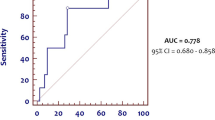Abstract
Fetal inflammatory response syndrome is implicated as a cause of fetal or neonatal injury. We analyzed the relationship between the procalcitonin umbilical cord blood level and neonatal outcome. A total of 237 preterms born in a level III perinatal medicine unit of a French university hospital were enrolled in a prospective observational study. Measurement of the procalcitonin umbilical cord blood level was performed at birth. After hospitalization, surviving infants were enrolled in the regional follow-up program. Outcome data were recorded on standardized questionnaires. The main outcome measures were neonatal mortality and impaired functional outcome at 2 years of corrected age. The terciles of procalcitonin levels were calculated. Preterm infants of the third tercile were defined as infants with elevated procalcitonin. Among the 237 infants, 13 (5.5%) died during the neonatal period, 20 (8.4%) were lost to follow-up, and 31 (13.1%) were classified as having an impaired functional outcome. After adjustment, elevated cord blood procalcitonin (>0.33 ng/ml) was significantly associated with an increase in mortality (adjusted odds ratio [aOR] = 8.3 [1.4–48]; p = 0.018), but not with the 2-year impaired functional outcome (aOR = 1.0 [0.4–2.5]; p = 0.93). Elevated umbilical blood cord procalcitonin concentration is an independent risk factor of mortality in preterm infants at less than 33 weeks’ gestation.

Similar content being viewed by others
References
Ancel PY, Marret S, Larroque B et al; Epipage Study Group (2005) Are maternal hypertension and small-for-gestational age risk factors for severe intraventricular hemorrhage and cystic periventricular leukomalacia? Results of the EPIPAGE cohort study. Am J Obstet Gynecol 193:178–184
Yoon BH, Jun JK, Romero R et al (1997) Amniotic fluid inflammatory cytokines (interleukin-6, interleukin-1beta, and tumor necrosis factor-alpha), neonatal brain white matter lesions, and cerebral palsy. Am J Obstet Gynecol 177:19–26
Duggan PJ, Maalouf EF, Watts TL et al (2001) Intrauterine T-cell activation and increased proinflammatory cytokine concentrations in preterm infants with cerebral lesions. Lancet 358:1699–1700
Bashiri A, Burstein E, Mazor M (2006) Cerebral palsy and fetal inflammatory response syndrome: a review. J Perinat Med 34:5–12
Goepfert AR, Andrews WW, Carlo W et al (2004) Umbilical cord plasma interleukin-6 concentrations in preterm infants and risk of neonatal morbidity. Am J Obstet Gynecol 191:1375–1381
Stocker M, Fontana M, El Helou S et al (2010) Use of procalcitonin-guided decision-making to shorten antibiotic therapy in suspected neonatal early-onset sepsis: prospective randomized intervention trial. Neonatology 97:165–174
Joram N, Muller JB, Denizot S et al (2011) Umbilical cord blood procalcitonin level in early neonatal infections: a 4-year university hospital cohort study. Eur J Clin Microbiol Infect Dis 30:1005–1013
Fily A, Pierrat V, Delporte V et al (2006) Factors associated with neurodevelopmental outcome at 2 years after very preterm birth: the population-based Nord-Pas-de-Calais EPIPAGE cohort. Pediatrics 117:357–366
Sices L, Stancin T, Kirchner L et al (2009) PEDS and ASQ developmental screening tests may not identify the same children. Pediatrics 124:e640–e647
Haque KN (2005) Definitions of bloodstream infection in the newborn. Pediatr Crit Care Med 6:S45–S49
Goldstein B, Giroir B, Randolph A; International Consensus Conference on Pediatric Sepsis (2005) International pediatric sepsis consensus conference: definitions for sepsis and organ dysfunction in pediatrics. Pediatr Crit Care Med 6:2–8
Kallapur SG, Jobe AH (2006) Contribution of inflammation to lung injury and development. Arch Dis Child Fetal Neonatal Ed 91:F132–F135
Turner D, Hammerman C, Rudensky B et al (2006) Procalcitonin in preterm infants during the first few days of life: introducing an age related nomogram. Arch Dis Child Fetal Neonatal 91:F283–F286
Lapillonne A, Basson E, Monneret G et al (1998) Lack of specificity of procalcitonin for sepsis diagnosis in premature infants. Lancet 351:1211–1212
Malin GL, Morris RK, Khan KS (2010) Strength of association between umbilical cord pH and perinatal and long term outcomes: systematic review and meta-analysis. BMJ 340:c1471
Acknowledgments
We thank Professor Veronique Gournay for her help in preparing the manuscript.
Author information
Authors and Affiliations
Corresponding author
Rights and permissions
About this article
Cite this article
Lautridou, A., Ancel, PY., Launay, E. et al. Umbilical cord blood procalcitonin as a risk factor for mortality in very premature infants. Eur J Clin Microbiol Infect Dis 31, 2407–2412 (2012). https://doi.org/10.1007/s10096-012-1583-0
Received:
Accepted:
Published:
Issue Date:
DOI: https://doi.org/10.1007/s10096-012-1583-0




